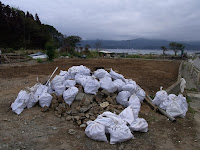First of all - a confession - I give summer holiday homework.
But - it's always in consultation with students about what they think will help them to retain and use English in the 7 week break.
I often hear complaints about summer holiday "busy work". Charts to fill in checking that you got up before 7, participated in the town morning exercise each day, go to bed before 8.30 and other nonsense that the school has no business mandating. Hiro's niece emailed the other day with help with her English - the difference between something and anything - because they were having a test in the middle of the holidays. (Holiday doesn't translate well perhaps....)
This morning I got an urgent call from Hiro's cousin. Her daugher in 4th grade hadn't finished the last part of her homework, due tomorrow and despite their best efforts was real struggling. (I emphasize THEIR best effort and send out very belated thanks to my father for patiently doing innumerable Burke and Wills assignments while we were in primary school.)
The holiday homework was to ask foreigners how to say 5 simple phrases in their home language. Good morning, Good afternoon, Thank you, Sorry and Goodbye. (please might have been good to throw in... never mind it was already enough busy work.) So cousin in law's daughter had dutifully been to Nikko and hung about at the shrine (I assume with her parents) to harrass unsuspecting foreigners. The UFs kindly wrote the words. However, because daughter of cousin in law DoCIL is 10 years old or so, and because roman script isn't that familiar to her, let alone the diacrit heavy Polish, or Czech she couldn't rewrite them and couldn't work out the pronunciation.
Although Italian and Catalan are somewhat familiar, speaking English doesn't necessarily mean one can also read or speak Czech, Dutch, or Polish - after all I come from the country where the highest mountain Kosciuszko, named after Pole, was misspelt for most of its lifespan with that name, and the local pronunciation bares no resemblance at all to Polish.

Sadly, it was easier for me to transcribe it in Japanese myself than explaining to them how to do it. eg English -> Polish translation dictionary to check spelling where the writing was unclear.
Google in Japanese "Polish greetings pronunciation" etc etc etc - 3 hours later.....
The last one she sent had me utterly flummoxed
ಬೆಳಿಗ್ಗೆ ಉತ್ತಮ
ಧನ್ಯವಾದಗಳು
ಕ್ಷಮಿಸಿ
Fortunately they had written it was Indian, which meant it wasn't Thai or Cambodian or Burmese
Give thanks for Google translate.
Hindi X Marathi X Urdu X Bengali X Gujurati X Malayam - doesn't feature, Tamil X
Telegu - maybe - must be from the south with such roundness to the form...
Kannada - YATTA!!!! -
At least I am 95% sure so....
Having established it was Kannada, the language spoken in Bangalore / MySore area, I could muddle through with google translate - the Rosetta Stone of the contemporary age.
And I ask myself...
1) Is this reasonable homework for a 10 year old
2) Why on earth do parents tolerate such nonsense busy work....
The first is a no brainer; the second..... I have no idea.
You might be asking 3 ) Why on earth get sucked into this sort of nonsense busy work....
Simple answer, Hiro's CIL is very nice and very good natured and very close to Hiro... the summer holiday battle is not mine to fight.













































